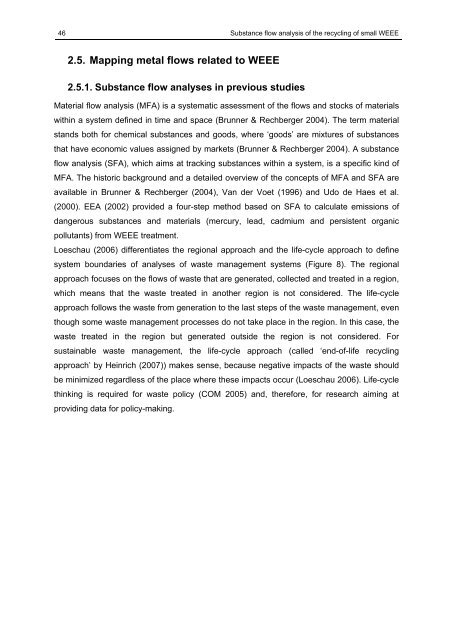SUbstance flow analysis of the recycling of small waste electrical ...
SUbstance flow analysis of the recycling of small waste electrical ...
SUbstance flow analysis of the recycling of small waste electrical ...
Create successful ePaper yourself
Turn your PDF publications into a flip-book with our unique Google optimized e-Paper software.
46 Substance <strong>flow</strong> <strong>analysis</strong> <strong>of</strong> <strong>the</strong> <strong>recycling</strong> <strong>of</strong> <strong>small</strong> WEEE<br />
2.5. Mapping metal <strong>flow</strong>s related to WEEE<br />
2.5.1. Substance <strong>flow</strong> analyses in previous studies<br />
Material <strong>flow</strong> <strong>analysis</strong> (MFA) is a systematic assessment <strong>of</strong> <strong>the</strong> <strong>flow</strong>s and stocks <strong>of</strong> materials<br />
within a system defined in time and space (Brunner & Rechberger 2004). The term material<br />
stands both for chemical substances and goods, where ‘goods’ are mixtures <strong>of</strong> substances<br />
that have economic values assigned by markets (Brunner & Rechberger 2004). A substance<br />
<strong>flow</strong> <strong>analysis</strong> (SFA), which aims at tracking substances within a system, is a specific kind <strong>of</strong><br />
MFA. The historic background and a detailed overview <strong>of</strong> <strong>the</strong> concepts <strong>of</strong> MFA and SFA are<br />
available in Brunner & Rechberger (2004), Van der Voet (1996) and Udo de Haes et al.<br />
(2000). EEA (2002) provided a four-step method based on SFA to calculate emissions <strong>of</strong><br />
dangerous substances and materials (mercury, lead, cadmium and persistent organic<br />
pollutants) from WEEE treatment.<br />
Loeschau (2006) differentiates <strong>the</strong> regional approach and <strong>the</strong> life-cycle approach to define<br />
system boundaries <strong>of</strong> analyses <strong>of</strong> <strong>waste</strong> management systems (Figure 8). The regional<br />
approach focuses on <strong>the</strong> <strong>flow</strong>s <strong>of</strong> <strong>waste</strong> that are generated, collected and treated in a region,<br />
which means that <strong>the</strong> <strong>waste</strong> treated in ano<strong>the</strong>r region is not considered. The life-cycle<br />
approach follows <strong>the</strong> <strong>waste</strong> from generation to <strong>the</strong> last steps <strong>of</strong> <strong>the</strong> <strong>waste</strong> management, even<br />
though some <strong>waste</strong> management processes do not take place in <strong>the</strong> region. In this case, <strong>the</strong><br />
<strong>waste</strong> treated in <strong>the</strong> region but generated outside <strong>the</strong> region is not considered. For<br />
sustainable <strong>waste</strong> management, <strong>the</strong> life-cycle approach (called ‘end-<strong>of</strong>-life <strong>recycling</strong><br />
approach’ by Heinrich (2007)) makes sense, because negative impacts <strong>of</strong> <strong>the</strong> <strong>waste</strong> should<br />
be minimized regardless <strong>of</strong> <strong>the</strong> place where <strong>the</strong>se impacts occur (Loeschau 2006). Life-cycle<br />
thinking is required for <strong>waste</strong> policy (COM 2005) and, <strong>the</strong>refore, for research aiming at<br />
providing data for policy-making.

















